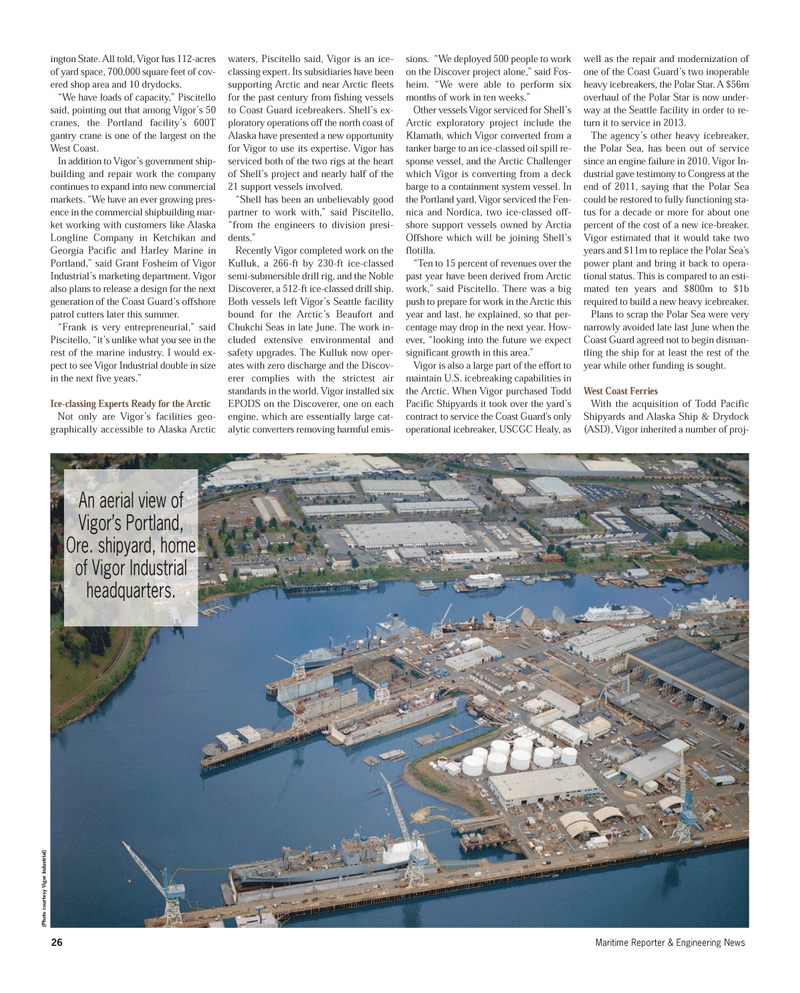
Page 26: of Maritime Reporter Magazine (July 2012)
Arctic Operations
Read this page in Pdf, Flash or Html5 edition of July 2012 Maritime Reporter Magazine
26Maritime Reporter & Engineering News ington State. All told, Vigor has 112-acres of yard space, 700,000 square feet of cov- ered shop area and 10 drydocks.?We have loads of capacity,? Piscitello said, pointing out that among Vigor?s 50 cranes, the Portland facility?s 600T gantry crane is one of the largest on the West Coast. In addition to Vigor?s government ship- building and repair work the company continues to expand into new commercial markets. ?We have an ever growing pres- ence in the commercial shipbuilding mar- ket working with customers like Alaska Longline Company in Ketchikan and Georgia Pacific and Harley Marine in Portland,? said Grant Fosheim of Vigor Industrial?s marketing department. Vigor also plans to release a design for the next generation of the Coast Guard?s offshore patrol cutters later this summer. ?Frank is very entrepreneurial,? said Piscitello, ?it?s unlike what you see in the rest of the marine industry. I would ex- pect to see Vigor Industrial double in size in the next five years.? Ice-classing Experts Ready for the Arctic Not only are Vigor?s facilities geo- graphically accessible to Alaska Arctic waters, Piscitello said, Vigor is an ice- classing expert. Its subsidiaries have been supporting Arctic and near Arctic fleets for the past century from fishing vessels to Coast Guard icebreakers. Shell?s ex- ploratory operations off the north coast of Alaska have presented a new opportunity for Vigor to use its expertise. Vigor has serviced both of the two rigs at the heart of Shell?s project and nearly half of the 21 support vessels involved. ?Shell has been an unbelievably good partner to work with,? said Piscitello, ?from the engineers to division presi- dents.? Recently Vigor completed work on the Kulluk, a 266-ft by 230-ft ice-classed semi-submersible drill rig, and the NobleDiscoverer, a 512-ft ice-classed drill ship. Both vessels left Vigor?s Seattle facility bound for the Arctic?s Beaufort and Chukchi Seas in late June. The work in- cluded extensive environmental and safety upgrades. The Kulluk now oper- ates with zero discharge and the Discov- erer complies with the strictest airstandards in the world. Vigor installed six EPODS on the Discoverer, one on each engine, which are essentially large cat- alytic converters removing harmful emis- sions. ?We deployed 500 people to work on the Discover project alone,? said Fos- heim. ?We were able to perform six months of work in ten weeks.? Other vessels Vigor serviced for Shell?s Arctic exploratory project include the Klamath, which Vigor converted from a tanker barge to an ice-classed oil spill re- sponse vessel, and the Arctic Challenger which Vigor is converting from a deck barge to a containment system vessel. In the Portland yard, Vigor serviced the Fen- nica and Nordica, two ice-classed off- shore support vessels owned by Arctia Offshore which will be joining Shell?s flotilla.?Ten to 15 percent of revenues over the past year have been derived from Arctic work,? said Piscitello. There was a big push to prepare for work in the Arctic this year and last, he explained, so that per- centage may drop in the next year. How- ever, ?looking into the future we expect significant growth in this area.? Vigor is also a large part of the effort to maintain U.S. icebreaking capabilities inthe Arctic. When Vigor purchased Todd Pacific Shipyards it took over the yard?s contract to service the Coast Guard's onlyoperational icebreaker, USCGC Healy, as well as the repair and modernization ofone of the Coast Guard?s two inoperable heavy icebreakers, the Polar Star. A $56m overhaul of the Polar Star is now under- way at the Seattle facility in order to re- turn it to service in 2013. The agency?s other heavy icebreaker, the Polar Sea, has been out of servicesince an engine failure in 2010. Vigor In- dustrial gave testimony to Congress at the end of 2011, saying that the Polar Seacould be restored to fully functioning sta-tus for a decade or more for about onepercent of the cost of a new ice-breaker. Vigor estimated that it would take two years and $11m to replace the Polar Sea'spower plant and bring it back to opera- tional status. This is compared to an esti- mated ten years and $800m to $1brequired to build a new heavy icebreaker. Plans to scrap the Polar Sea were very narrowly avoided late last June when the Coast Guard agreed not to begin disman- tling the ship for at least the rest of theyear while other funding is sought.West Coast Ferries With the acquisition of Todd Pacific Shipyards and Alaska Ship & Drydock (ASD), Vigor inherited a number of proj- An aerial view ofVigor?s Portland, Ore. shipyard, home of Vigor Industrial headquarters. (Photo courtesy Vigor Industrial) MR#7 (26-33):MR Template 7/9/2012 9:40 AM Page 26

 25
25

 27
27
